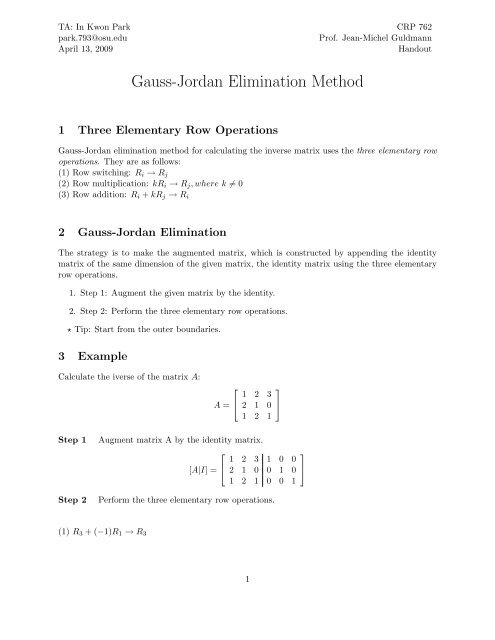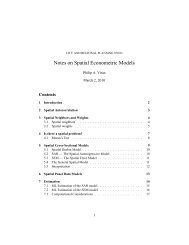Gauss-Jordan Elimination Method - The Ohio State University
Gauss-Jordan Elimination Method - The Ohio State University
Gauss-Jordan Elimination Method - The Ohio State University
You also want an ePaper? Increase the reach of your titles
YUMPU automatically turns print PDFs into web optimized ePapers that Google loves.
TA: In Kwon Park CRP 762<br />
park.793@osu.edu<br />
Prof. Jean-Michel Guldmann<br />
April 13, 2009<br />
Handout<br />
<strong>Gauss</strong>-<strong>Jordan</strong> <strong>Elimination</strong> <strong>Method</strong><br />
1 Three Elementary Row Operations<br />
<strong>Gauss</strong>-<strong>Jordan</strong> elimination method for calculating the inverse matrix uses the three elementary row<br />
operations. <strong>The</strong>y are as follows:<br />
(1) Row switching: R i → R j<br />
(2) Row multiplication: kR i → R j , where k ≠ 0<br />
(3) Row addition: R i + kR j → R i<br />
2 <strong>Gauss</strong>-<strong>Jordan</strong> <strong>Elimination</strong><br />
<strong>The</strong> strategy is to make the augmented matrix, which is constructed by appending the identity<br />
matrix of the same dimension of the given matrix, the identity matrix using the three elementary<br />
row operations.<br />
1. Step 1: Augment the given matrix by the identity.<br />
2. Step 2: Perform the three elementary row operations.<br />
⋆ Tip: Start from the outer boundaries.<br />
3 Example<br />
Calculate the iverse of the matrix A:<br />
⎡<br />
A = ⎣<br />
1 2 3<br />
2 1 0<br />
1 2 1<br />
⎤<br />
⎦<br />
Step 1<br />
Step 2<br />
Augment matrix A by the identity matrix.<br />
⎡<br />
1 2 3 1 0<br />
⎤<br />
0<br />
[A|I] = ⎣ 2 1 0 0 1 0 ⎦<br />
1 2 1 0 0 1<br />
Perform the three elementary row operations.<br />
(1) R 3 + (−1)R 1 → R 3<br />
1
Multiply Row 1 by −1, add it to Row 3, and substitute the result for Row 3.<br />
⎡<br />
1 2 3 1 0<br />
⎤<br />
0<br />
⎣ 2 1 0 0 1 0 ⎦<br />
0 0 −2 −1 0 1<br />
(2) − 1 2 R 3 → R 3<br />
Multiply Row 3 by − 1 2<br />
and substitute the result for Row 3.<br />
⎡<br />
⎤<br />
1 2 3 1 0 0<br />
⎣ 2 1 0 0 1 0 ⎦<br />
1<br />
0 0 1<br />
2<br />
0 − 1 2<br />
(3) R 1 + (−3)R 3 → R 1<br />
Multiply Row 3 by −3, add it to Row 1, and substitute the result for Row 1.<br />
⎡<br />
1 2 0 − 1 ⎤<br />
3<br />
2<br />
0<br />
2<br />
⎣ 2 1 0 0 1 0 ⎦<br />
1<br />
0 0 1<br />
2<br />
0 − 1 2<br />
(4) R 2 + (−2)R 1 → R 2<br />
Multiply Row 1 by −1, add it to Row 2, and substitute the result for Row 2.<br />
⎡<br />
1 2 0 − 1 ⎤<br />
3<br />
2<br />
0<br />
2<br />
⎣ 0 −3 0 1 1 −3 ⎦<br />
1<br />
0 0 1<br />
2<br />
0 − 1 2<br />
(5) − 1 3 R 2 → R 2<br />
Multiply Row 2 by − 1 3<br />
, and substitute the result for Row 2.<br />
⎡<br />
1 2 0 − 1 3<br />
2<br />
0<br />
2<br />
⎣ 0 1 0 − 1 3<br />
− 1 3<br />
1<br />
1<br />
0 0 1<br />
2<br />
0 − 1 2<br />
(6) R 1 + (−2)R 2 → R 1<br />
Multiply Row 2 by −2, add it to Row 1, and substitute the result for Row 1.<br />
⎡<br />
⎤<br />
1 2 1<br />
1 0 0<br />
6 3 2<br />
⎣ 0 1 0 − 1 3<br />
− 1 3<br />
1 ⎦<br />
1<br />
0 0 1<br />
2<br />
0 − 1 2<br />
<strong>The</strong> above matrix is equal to [ I|A −1] , and hence the inverse matrix of A is the right part of the<br />
matrix. That is,<br />
⎡<br />
A −1 = ⎣<br />
1<br />
6<br />
2<br />
3<br />
− 1 2<br />
− 1 3<br />
− 1 3<br />
1<br />
1<br />
2<br />
0 − 1 2<br />
⎤<br />
⎦<br />
⎤<br />
⎦<br />
2











